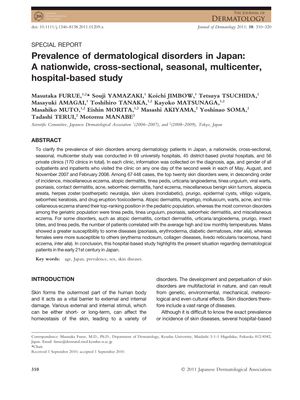Prevalence of Dermatological Disorders in Japan: A Nationwide, Cross-Sectional, Seasonal, Multicenter, Hospital-Based Study
March 2011
in “
Journal of Dermatology
”

TLDR Eczema and fungal infections are the most common skin problems in Japan, with different age groups and genders affected by various conditions.
In 2007, a comprehensive study involving 67,448 patients from 170 clinics in Japan found that eczematous and fungal diseases were the most prevalent dermatological disorders. The study revealed age-specific prevalence, with atopic dermatitis being most common in the 6-40 age group and miscellaneous eczema appearing across all ages. Gender differences were also noted, with males more prone to conditions like psoriasis and androgenic alopecia, while females were more affected by hand eczema, systemic sclerosis, and systemic lupus erythematosus. Climate factors, such as average temperatures and humidity, were found to correlate with the incidence of certain skin conditions. The study aimed to provide a detailed overview of dermatological conditions in Japan, despite acknowledging certain limitations and biases in its methodology.


